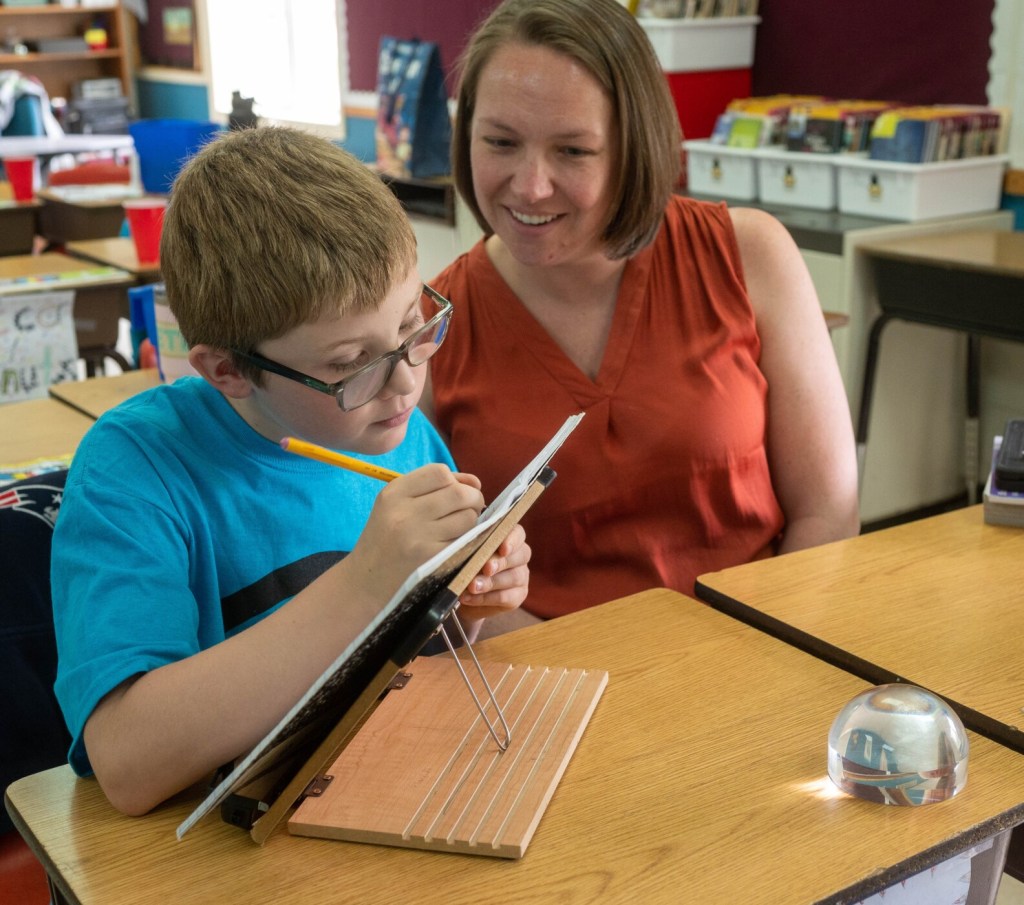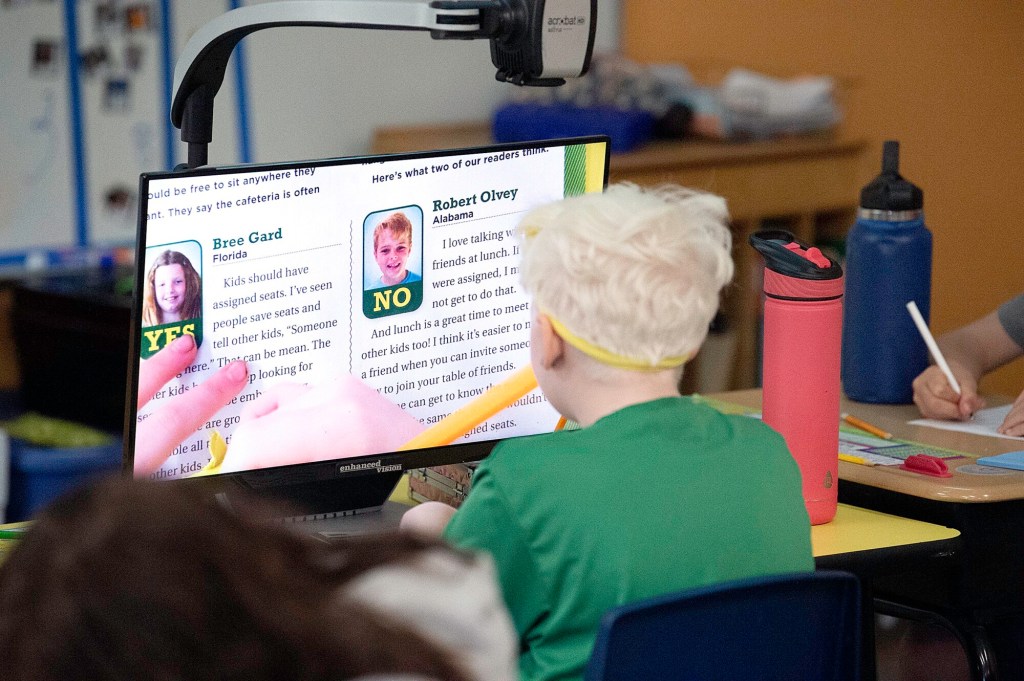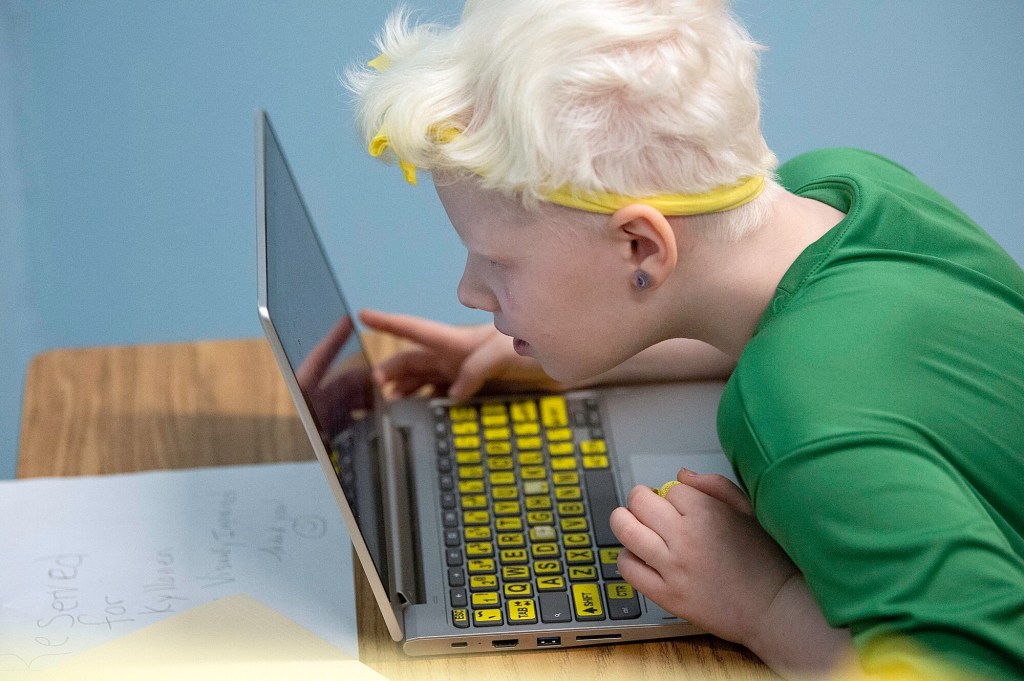POLAND — Taylor Downs sees the world differently than most of her peers.
The Poland Community School student sits at the front of her warmly-lit classroom, close to the blackboard but away from the windows. When the words in her textbooks or on the blackboard are too small for her to make out, she uses a closed-circuit television magnifier — more commonly known as a CCTV — to project the words on a large monitor sitting on her desk.
Learning at school as a visually impaired person can be difficult at times for the 9-year-old. Even day to day. Some days her vision is better, and some days it’s worse.
“(It’s) kind of annoying,” she said.
Downs was born with albinism, a rare genetic condition which gave her pale features and bad eyesight. Albinism affects the production of melanin, the pigment that colors hair, skin and eyes; it’s also involved in the development of the retina, a thin layer of cells at the back of the eye.
Albinism is one of many reasons children may be born with or develop visual impairments. Nationally, nearly 3% of children under 18 are blind or have a vision impairment, defined as having trouble seeing even when wearing glasses or contact lenses, according to the U.S. Centers for Disease Control and Prevention.

Taylor Downs does schoolwork May 9 in her third-grade classroom at Poland Community School. The 9-year-old is visually impaired and uses an enlarger to project her work onto a monitor that helps her see her progress. Daryn Slover/Sun Journal
People with albinism are also particularly sensitive to light. Because they lack pigment in their eyes, lights often appear far brighter to them. They are also more prone to severe sunburns and skin cancer.
“It feels like I’m a bit different from other people, because I just might not have the same eye, hair and skin color as them, but I’m also kind of the same,” she said. “I’ve been teaching my classmates certain things about blind and visually impaired people.”
Downs has the kind of confidence that would make most adults envious. She isn’t shy about telling others about herself or advocating for what she needs to succeed. Many of her friends know now to save her a spot at the front of the group during class activities, Downs said.
But Downs doesn’t have to learn to navigate school on her own. She also has a specialized teacher from Catholic Charities Maine who meets with her once a week.

Joyce Kyllonen works with Taylor Downs on her typing skills May 9 at Poland Community School in Poland. It is important that Downs learns to type in case her visual impairment worsens. Daryn Slover/Sun Journal
Joyce Kyllonen works with Downs and a dozen other children with vision impairments in central Maine, teaching them skills specific to their needs. While she meets with some of her students multiple times a week, others she sees just several times a year.
Catholic Charities Maine is the sole provider of teachers of the visually impaired in the the state, serving about 300 children from York to Aroostook County.
Nancy Moulton, director of Catholic Charities Maine’s education services for visually impaired children, has been a teacher with the nonprofit since 1988. Over the years, she’s seen the number of visually impaired children with complex needs grow. These are children who have other disabilities beyond their vision, she explained.
She estimated that over half of the children they serve have complex needs, primarily attributing the increase to advances in medical technology. Today, doctors are able to save the lives of more children with developmental disabilities or medical complications than they were in the past, she said.
KYLLONEN’S STUDENTS
Every Tuesday morning, Kyllonen helps Downs practice her typing skills on a laptop specially designed for people with bad eyesight. The keys are larger, bright yellow with black text, and have braille.
For 30 minutes, she practices typing phrases like “hot potato” and “on par” without looking at the keyboard, using a program created to teach blind people. She also plays online typing games which challenge her to find letters quickly.
“When I get older, my vision might get a bit worse,” Downs said. “I need to know my keys so it’s easy for me (to use computers).”
Teachers like Kyllonen assist and educate children from birth until high school graduation or 22 years of age, whichever comes first. These teachers meet students wherever they’re at, whether it’s a public, private or homeschool setting.
Many of their students, even those who are blind, are able to learn in classrooms alongside their peers, with minor adjustments. Others require specialized programs.
Schools will often hire an education technician to assist blind students, she said, helping to make lessons more accessible by reading education materials out loud or translating text into braille using a specialized machine.

Owen Bowie uses a slant board Thursday to bring a paper he is writing on closer to his eyes. His fifth grade teacher, Mollee Brooks, offers encouragement. Andree Kehn/Sun Journal
Owen Bowie, a fifth-grader at East Auburn Community School, is another one of Kyllonen’s students. He also has albinism like Downs, but a different, less severe type.
Kyllonen has been working with Bowie and his family since he was 4 months old. His vision is better than Downs — just missing the mark for the legal definition of blindness, his mother says — and Kyllonen often checks in with him and his teacher every few months.
Beyond working with students one-on-one, one of Kyllonen’s most important tasks is advising classroom teachers. At the start of the school year, she meets with all of her students’ teachers to help them understand the needs of visually impaired students.
“I can always see that nervousness that a teacher has because they’re not sure how is this going to work, especially if they’ve never had a student with a visual impairment,” Kyllonen said. “Then after a couple of months, you can see that they’re like, ‘Oh, this is so doable.'”
The most obvious change in Bowie and Downs’ classrooms is the cloth sleeves which cover the classroom lights. These sleeves reduce glare and dim the lighting, making it more comfortable for their sensitive eyes.
Bowie’s teacher, Mollee Brooks, has made other, more discrete changes to her fifth-grade classroom this year. She provides extra dark pencils for Bowie to use, at Kyllonen’s suggestion, and has adapted lessons to be more inclusive to his needs.
“(It’s) just little tweaks that make his day so much easier,” Brooks said. “They’re things that don’t take a lot of time or effort or energy on the teacher’s part, but they’re things that I would never know existed if I didn’t have Joyce.”
Bowie doesn’t have a CCTV like Downs. Instead, he primarily uses a handheld magnifier and an iPad, which has been especially useful.
He recalled a time recently when he was having difficulty reading a story in one of his textbooks. Even with the help of his magnifier, he still couldn’t read the text. Instead, he and his teacher were able to find the same story on his iPad, which enables him to zoom in and enlarge the text.
Advancements in technology have played a crucial role in making everything from education to employment opportunities to recreational opportunities more accessible to people with visual impairments.

Owen Bowie, 10, uses a globe magnifier Thursday to enlarge text and images in books at the East Auburn Community School. Andree Kehn/Sun Journal
Bowie’s dad, a hunter, bought a cellphone mount for Bowie’s crossbow to help him see better.
“When he puts it on the camera mode, it puts the crosshairs in the phone and makes everything bigger so I can actually see it,” Bowie said.
Both Downs and Bowie said they wished people could understand their disabilities without having to explain it.
“I wish (people would) understand better that some people can’t see as well as them and that other people might not get things as clear as they can,” Downs said.
“It really is hard for them, it’s a struggle,” Bowie’s mother, Allison, said. “A lot of people tend to forget that he has a disability and that he does have a hard time. It’s easy because he does cope so well.”
TECHNOLOGY ADVANCES
Steve Hoad of Windsor has personally experienced the evolution of accessible technology. Growing up in New Jersey as a blind student in the 1950s and 1960s, he was able to attend public school with help from a teacher of the visually impaired.
New Jersey provided ample resources for educating blind students, he said. All of his textbooks were available in braille, and if he wanted to read a book from the library, the school would order a translated copy. In the third grade, he learned to use a typewriter to complete his assignments.
Learning at Bates College in Lewiston was far more difficult, he said, because his textbooks were only available on tape.
As a child, his parents would read him articles and comics in the newspaper. Then, he couldn’t read the paper unless someone read the article aloud.
Now, a screen reading program enables Hoad to “read” dozens of news articles each day and make connections on Twitter, among many other things.
Hoad emphasized the importance of teaching visually impaired children, especially blind children, life skills.
“I know some older blind folks who have really suffered because they weren’t taught some of the skills, not just computer skills, but some of the general skills that are very necessary to operate as an independent blind person,” he said.

Steve Hoad stands in 2011 on his Windsor farm. “There has to be a mindset within each person that teaches a blind student that that blind student is normal,” he says. “That’s very hard.” Portland Press Herald file
In addition to their school services, teachers like Kyllonen also host field trips designed to help visually impaired children and their families build community and practice important life skills.
On a recent field trip to a church in Turner, older students were tasked with creating a budget, shopping at Hannaford, and preparing a meal. Students were able to use a tactile or high contrast large print map of the grocery store prepared by one of the teachers, if needed.
In the kitchen, students practiced cutting food, opening ovens, determining when food is done cooking and more.
“If you can’t see, there’s so many skills to learn and those skills need to be taught directly,” Kyllonen said. “Sometimes we do those individually with a student, but it’s so much more fun to get students together.”
Another recent field trip for younger students in Westbrook offered arts and crafts and other activities.
Every year near Christmas, older students are invited to participate in the annual Maine Mall scavenger hunt. Students complete a variety of tasks in the mall, have lunch, then go Christmas shopping in the afternoon. Younger students are taken to Walmart to shop for Christmas presents, an activity Downs said she loved.
“It was strange, because I’ve never really met anyone that’s like me,” she said. “I also met some blind people, (and) I worked really well with them.”
Hoad, for his part, said some people think he might be a little too independent for his own good. With little access to public transportation in rural Maine, he sometimes hitchhikes when traveling and doesn’t hesitate to use a chainsaw, something his neighbors have said makes them nervous.
“There has to be a mindset within each person that teaches a blind student that that blind student is normal,” he said. “That’s very hard.”
Send questions/comments to the editors.













Comments are no longer available on this story